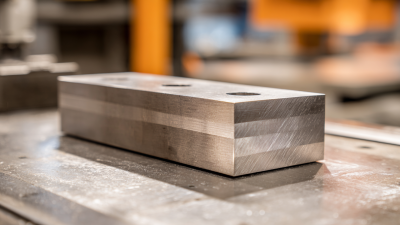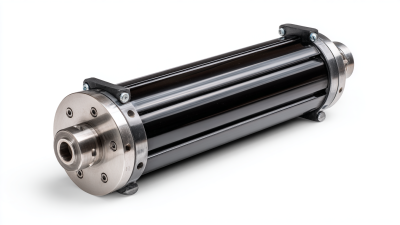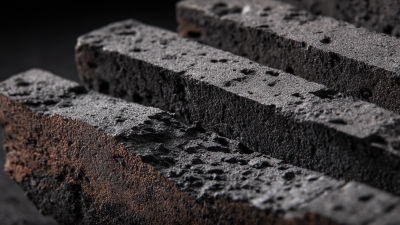Unlocking the Future of Precision Ceramic Parts in High Performance Applications
Table of Contents
- The Evolution of Precision Ceramics in Industrial Applications
- Key Properties That Enhance Performance in High-Stress Environments
- Recent Technological Advances Driving Innovation in Ceramic Manufacturing
- Comparative Analysis: Ceramics vs. Traditional Materials in High Performance
- Future Trends in Precision Ceramic Components Across Various Industries
- FAQS
- Conclusion
- Related Posts
In today's rapidly evolving industrial landscape, the demand for high-performance applications is driving the need for advanced materials, particularly Precision Ceramic Parts. These components offer unparalleled durability, thermal resistance, and precision, making them indispensable in sectors ranging from aerospace to electronics. At the forefront of this technological advancement is ST.CERA CO., LTD., a private high-tech enterprise that specializes in precision ceramic manufacturing. With a dedicated team of top-ranking experts and engineers, ST.CERA excels in research and development, manufacturing, and marketing of precision ceramic parts tailored to meet the rigorous demands of high-performance applications. This article will explore the innovations and strategies necessary to unlock the future of precision ceramics, ensuring that industries continue to benefit from these remarkable materials.

The Evolution of Precision Ceramics in Industrial Applications
The evolution of precision ceramics has marked a significant transformation in industrial applications, driven by the need for materials that can withstand extreme conditions while providing unparalleled performance. Initially used in traditional industries, ceramics have now advanced to support high-performance demands in sectors such as aerospace, automotive, and electronics. These materials are now engineered to possess higher strength, improved fracture toughness, and superior thermal stability, meeting the rigorous requirements of modern manufacturing.
Innovations in processing techniques and material formulations are at the forefront of this evolution. Advanced methods, such as additive manufacturing and nano-structuring, have enabled the production of intricate geometries and enhanced functionalities. As a result, precision ceramics are no longer limited to simple shapes but can now be designed to optimize performance characteristics specific to their applications. This evolution not only broadens the scope of what ceramics can achieve but also promises new possibilities for enhancing efficiency and performance in high-stakes environments.
Key Properties That Enhance Performance in High-Stress Environments
 In high-performance applications, the demand for precision ceramic parts continues to grow, driven by their unique properties that enhance performance in high-stress environments. Key attributes such as exceptional hardness, wear resistance, and thermal stability make ceramics an ideal choice for industries ranging from aerospace to medical devices. These materials withstand extreme temperatures and corrosive conditions, which are often encountered in demanding operational contexts.
In high-performance applications, the demand for precision ceramic parts continues to grow, driven by their unique properties that enhance performance in high-stress environments. Key attributes such as exceptional hardness, wear resistance, and thermal stability make ceramics an ideal choice for industries ranging from aerospace to medical devices. These materials withstand extreme temperatures and corrosive conditions, which are often encountered in demanding operational contexts.
When selecting ceramics for high-stress applications, consider the impact of microstructure. The refinement of grain size leads to improved strength and toughness, allowing components to perform reliably under pressure. Additionally, incorporating additives and employing advanced manufacturing techniques can further enhance the mechanical properties of these parts.
Tips: Always consult with materials scientists or engineers to understand the specific requirements for your application, as the right ceramic composition can significantly affect durability and performance. Moreover, keeping an eye on emerging technologies in ceramic processing can reveal innovative solutions that boost efficiency and reliability in your projects.
Recent Technological Advances Driving Innovation in Ceramic Manufacturing
Recent advancements in ceramic manufacturing technology are transforming the landscape of precision ceramic parts, especially in high-performance applications. Innovations such as additive manufacturing and advanced sintering techniques are enabling the creation of intricate geometries with exceptional material properties. These methods not only enhance structural integrity and thermal resistance but also significantly reduce production times, making them ideal for industries ranging from aerospace to medical devices.

Furthermore, the development of new ceramic composites is paving the way for improved performance characteristics, including increased toughness and reduced weight. By incorporating materials like silicon carbide and alumina with advanced bonding techniques, manufacturers can produce components that withstand extreme conditions while maintaining precision. As these technological breakthroughs continue to emerge, they promise to unlock new possibilities for the application of ceramics in demanding environments, driving innovation and setting new industry standards.
Comparative Analysis: Ceramics vs. Traditional Materials in High Performance
In the quest for high-performance applications, the choice of materials can significantly impact both functionality and longevity. Traditional materials, such as metals and plastics, have dominated many industries for years. However, when it comes to extreme conditions—like high temperatures, corrosive environments, or extreme wear—the limitations of these materials become evident. This is where advanced ceramics shine.
Known for their superior thermal stability, wear resistance, and lightweight characteristics, ceramics provide a compelling alternative. Their ability to maintain integrity under stress allows for innovative designs and solutions in aerospace, automotive, and energy sectors.
Tip: When considering materials for your next project, assess the operating conditions thoroughly. If your application involves high temperatures or harsh environments, ceramics might offer the resilience needed that traditional materials cannot.
Furthermore, cost-effectiveness and manufacturing processes also play critical roles in material selection. While ceramics may have higher upfront costs and complex fabrication processes compared to metals, their lifecycle benefits, such as reduced maintenance and longer service life, can prove to be more economical in the long run. As industries increasingly embrace advanced ceramics, a comparative analysis of performance metrics against traditional materials can help guide crucial decisions for future developments.
Tip: Keep an eye on emerging manufacturing techniques, such as 3D printing, which may lower the costs and complexity associated with producing high-performance ceramic components.
Future Trends in Precision Ceramic Components Across Various Industries
The future of precision ceramic components is bright, with emerging trends shaping their application across various industries. As advanced manufacturing processes evolve, the demand for high-performance ceramic parts continues to grow, particularly in the aerospace, automotive, and medical fields. According to a recent market report, the global ceramic components market is projected to reach $12 billion by 2025, with a compound annual growth rate (CAGR) of 7.5%. This growth is driven by the superior properties of ceramics, such as their lightweight nature, thermal stability, and enhanced wear resistance.
At St.Cera Co., Ltd., we are at the forefront of this transformation, utilizing cutting-edge technology and a team of top-ranking experts to develop precision ceramic parts tailored to meet industry demands. Our focus on research and development ensures we stay ahead of trends, leading to innovative solutions that enhance performance in high-stakes applications.
**Tip:** When selecting precision ceramic components, consider their thermal and mechanical properties to ensure they meet the specifications of your application. Understanding these characteristics will help you achieve optimal performance and longevity. Additionally, exploring advanced manufacturing techniques, such as additive manufacturing, can further enhance the capabilities of ceramic parts in various sectors.
Future Trends in Precision Ceramic Components Across Various Industries
This chart illustrates the projected growth in adoption of precision ceramic components across various industries by the year 2025. The data indicates an increasing trend in applications such as electronics, automotive, aerospace, and medical fields.
FAQS
: The evolution of precision ceramics has significantly impacted industries such as aerospace, automotive, and electronics, which require materials capable of withstanding extreme conditions.
Precision ceramics are known for their exceptional hardness, wear resistance, and thermal stability, making them suitable for demanding applications.
The refinement of grain size in ceramics can lead to improved strength and toughness, allowing components to perform reliably under pressure.
Innovations such as additive manufacturing and advanced sintering techniques are key to producing intricate geometries with exceptional material properties.
New ceramic composites incorporate materials like silicon carbide and alumina with advanced bonding techniques, resulting in increased toughness and reduced weight.
Consulting with experts ensures that the right ceramic composition is chosen for specific applications, significantly affecting the durability and performance of the components.
Advancements in ceramic processing technologies unlock new possibilities for material applications, driving efficiency and reliability in high-performance environments.
Innovations in manufacturing techniques, such as additive manufacturing, significantly reduce production times while enhancing structural integrity and thermal resistance.
Companies should stay informed about emerging technologies, as they can reveal innovative solutions that enhance efficiency and performance in various projects.
Initially used in traditional industries, ceramics have advanced to meet high-performance demands in modern manufacturing, expanding their capabilities beyond simple shapes.
Conclusion
The article "Unlocking the Future of Precision Ceramic Parts in High Performance Applications" explores the significant evolution and advancements in precision ceramics for industrial uses. It highlights the key properties that make these materials ideally suited for high-stress environments, such as their superior hardness, thermal stability, and corrosion resistance. Recent technological innovations in ceramic manufacturing are also discussed, showcasing how these developments are enhancing the performance and reliability of precision ceramic parts.
Furthermore, the article provides a comparative analysis of ceramics versus traditional materials, underscoring the advantages of using precision ceramic components in various high-performance industries. As we look towards the future, emerging trends suggest a growing integration of precision ceramic parts across diverse applications, driven by continuous research and innovation in the field. St.Cera Co., Ltd., as a leader in precision ceramic manufacturing, is well-positioned to capitalize on these trends, leveraging its expertise to deliver cutting-edge solutions to meet the evolving needs of the industry.
Related Posts
-

Navigating Global Trade Certifications for Best Al2o3 Ceramic Rod Purchases
-

Innovative Applications of Aluminum Nitride Plates in Modern Technology
-

Revolutionizing Automation with Advanced Gripper End Effectors for Seamless Operations
-

Ultimate Checklist for Sourcing the Best Beo Ceramic Tube for Your Business Needs
-

How to Choose the Best Silicon Carbide Plates for Your Industrial Needs
-

The Ultimate Guide to Sourcing ESD Ceramic Support Arms for Enhanced Production Efficiency
Blog Tags:

